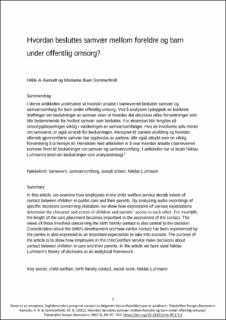| dc.contributor.author | Aamodt, Hilde Anette | |
| dc.contributor.author | Sommerfeldt, Marianne Buen | |
| dc.date.accessioned | 2023-02-28T08:29:49Z | |
| dc.date.available | 2023-02-28T08:29:49Z | |
| dc.date.created | 2022-10-22T14:17:21Z | |
| dc.date.issued | 2022 | |
| dc.identifier.citation | Tidsskriftet Norges Barnevern. 2022, 99 (2-3), 80-97. | en_US |
| dc.identifier.issn | 0800-1014 | |
| dc.identifier.issn | 1891-1838 | |
| dc.identifier.uri | https://hdl.handle.net/11250/3054509 | |
| dc.description.abstract | I denne artikkelen undersøker vi hvordan ansatte i barnevernet beslutter samvær og samværsomfang for barn under offentlig omsorg. Ved å analysere lydopptak av konkrete drøftinger om beslutninger av samvær viser vi hvordan det uttrykkes ulike forventninger som blir bestemmende for hvilket samvær som besluttes. For eksempel blir lengden på omsorgsplasseringen viktig i vurderingen av samværsomfanget. Hva de involverte selv mener om samværet, er også sentralt for beslutningen. Hensynet til barnets utvikling og hvordan allerede gjennomførte samvær har opplevdes av partene, blir også uttrykt som en viktig forventning å ta hensyn til. Hensikten med artikkelen er å vise hvordan ansatte i barnevernet kommer frem til beslutninger om samvær og samværsomfang. I artikkelen har vi brukt Niklas Luhmanns teori om beslutninger som analysestrategi.
In this article, we examine how employees in the child welfare service decide extent of contact between children in public care and their parents. By analyzing audio recordings of specific decisions concerning visitation, we show how expressions of various expectations determine the character and extent of children and parents’ access to each other. For example, the length of the care placement becomes important in the assessment of the contact. The views of those involved concerning the birth family contact is also central to the decision. Consideration about the child's development and how earlier contact has been experienced by the parties is also expressed as an important expectation to take into account. The purpose of the article is to show how employees in the child welfare service make decisions about contact between children in care and their parents. In the article we have used Niklas Luhmann's theory of decisions as an analytical framework. | en_US |
| dc.language.iso | nob | en_US |
| dc.publisher | Universitetsforlaget | en_US |
| dc.relation.ispartofseries | Tidsskriftet Norges Barnevern;Volum 99 | Utgave 2-3 | |
| dc.title | Hvordan besluttes samvær mellom foreldre og barn under offentlig omsorg? | en_US |
| dc.type | Peer reviewed | en_US |
| dc.type | Journal article | en_US |
| dc.description.version | publishedVersion | en_US |
| cristin.ispublished | true | |
| cristin.fulltext | original | |
| cristin.qualitycode | 1 | |
| dc.identifier.doi | https://doi.org/10.18261/tnb.99.2-3.2 | |
| dc.identifier.cristin | 2063969 | |
| dc.source.journal | Tidsskriftet Norges Barnevern | en_US |
| dc.source.volume | 99 | en_US |
| dc.source.issue | 2-3 | en_US |
| dc.source.pagenumber | 23 | en_US |
